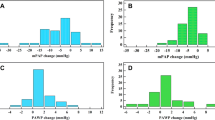Abstract
Purpose
This study aimed to identify the relationship between pulmonary vascular capacitance (PVC) and vasoreactivity in patients with idiopathic pulmonary arterial hypertension (IPAH), and the value of PVC in predicting long-term response to CCB treatment.
Methods
Pulmonary vasodilator testing with inhaling iloprost was performed in 308 newly diagnosed IPAH patients. Acute vasodilator-responsive patients accepted CCBs treatment. Patients who benefit from long-term CCB were defined as those being in World Health Organization (WHO) functional class II or I after at least 1 year on CCB monotherapy.
Results
PVC had significant correlations with WHO function class, 6-min walk distance, mean pulmonary arterial pressure, and pulmonary vascular resistance (r = −0.363, p < 0.001; r = 0.333, p < 0.001; r = −0.514, p < 0.001; r = −0.739, p < 0.001). Thirty-five acute vasodilator-responsive IPAH patients (11.4 %) displayed less severe disease and a higher baseline PVC (1.5 ± 0.6 vs. 1.1 ± 0.7 ml/mmHg, p = 0.003). During acute vasodilator testing, PVC increased significantly by mean of 79 ± 48 % and reached to a higher absolute value of 2.6 ± 1.5 ml/mmHg compared with non-responsive patients (1.4 ± 1.5 ml/mmHg, p < 0.001). Furthermore, PVC increased more during acute vasodilator testing in the 24 patients who benefit from long-term CCB treatment (1.4 ± 1.3 vs. 0.5 ± 0.4 ml/mmHg, p = 0.004). The OR of increased PVC during vasodilator testing for predicting patients with long-term response to CCB was 1.24 (95 % CI 1.02–1.50, p = 0.031) as assessed by multivariable logistic regression analysis.
Conclusions
PVC was higher in acute vasodilator-responsive IPAH patients and may be a predictor of long-term response to CCBs therapy.

Similar content being viewed by others
References
Sitbon O, Humbert M, Jagot JL et al (1998) Inhaled nitric oxide as a screening agent for safely identifying responders to oral calcium-channel blockers in primary pulmonary hypertension. Eur Respir J 12(2):265–270
Rich S, Kaufmann E, Levy PS (1992) The effect of high doses of calcium-channel blockers on survival in primary pulmonary hypertension. N Engl J Med 327(2):76–81
Sitbon O, Humbert M, Jaïs X et al (2005) Long-term response to calcium channel blockers in idiopathic pulmonary arterial hypertension. Circulation 111(23):3105–3111
Jing ZC, Jiang X, Han ZY et al (2009) Iloprost for pulmonary vasodilator testing in idiopathic pulmonary arterial hypertension. Eur Respir J 33(6):1354–1360
Lankhaar JW, Westerhof N, Faes TJ et al (2006) Quantification of right ventricular afterload in patients with and without pulmonary hypertension. Am J Physiol Heart Circ Physiol 291(4):H1731–H1737
Lankhaar JW, Westerhof N, Faes TJ et al (2008) Pulmonary vascular resistance and compliance stay inversely related during treatment of pulmonary hypertension. Eur Heart J 29(13):1688–1695
Galiè N, Hoeper MM, Humbert M et al (2009) Guidelines for the diagnosis and treatment of pulmonary hypertension. Eur Heart J 30(20):2493–2537
Tuder RM, Abman SH, Braun T et al (2009) Development and pathology of pulmonary hypertension. J Am Coll Cardiol 54(1 Suppl.):S3–S9
McLaughlin VV, Davis M, Cornwell W (2011) Pulmonary arterial hypertension. Curr Probl Cardiol 36(12):461–517
Chemla D, Castelain V, Hervé P et al (2002) Haemodynamic evaluation of pulmonary hypertension. Eur Respir J 20(5):1314–1331
Castelain V, Hervé P, Lecarpentier Y et al (2001) Pulmonary artery pulse pressure and wave reflection in chronic pulmonary thromboembolism and primary pulmonary hypertension. J Am Coll Cardiol 37(4):1085–1092
Lau EM, Iyer N, Ilsar R et al (2012) Abnormal pulmonary artery stiffness in pulmonary arterial hypertension: in vivo study with intravascular ultrasound. PLoS One 7(3):e33331
Tedford RJ, Hassoun PM, Mathai SC et al (2012) Pulmonary capillary wedge pressure augments right ventricular pulsatile loading. Circulation 125(2):289–297
Hunter KS, Lee PF, Lanning CJ et al (2008) Pulmonary vascular input impedance is a combined measure of pulmonary vascular resistance and stiffness and predicts clinical outcomes better than pulmonary vascular resistance alone in pediatric patients with pulmonary hypertension. Am Heart J 155(1):166–174
Weir EK, Rubin LJ, Ayres SM et al (1989) The acute administration of vasodilators in primary pulmonary hypertension. Experience from the National Institutes of Health Registry on Primary Pulmonary Hypertension. Am Rev Respir Dis 140(6):1623–1630
Costa EL, Jardim C, Bogossian HB et al (2005) Acute vasodilator test in pulmonary arterial hypertension: evaluation of two response criteria. Vasc Pharmacol 43:143–147
Newman JH, Brittain EL, Robbins IM et al (2015) Effect of acute arteriolar vasodilation on capacitance and resistance in pulmonary arterial hypertension. Chest 147(4):1080–1085
Tonelli AR, Alnuaimat H, Mubarak K (2010) Pulmonary vasodilator testing and use of calcium channel blockers in pulmonary arterial hypertension. Respir Med 104(4):481–496
Mahapatra S, Nishimura RA, Sorajja P et al (2006) Relationship of pulmonary arterial capacitance and mortality in idiopathic pulmonary arterial hypertension. J Am Coll Cardiol 47(4):799–803
Gan CT, Lankhaar JW, Westerhof N et al (2007) Noninvasively assessed pulmonary artery stiffness predicts mortality in pulmonary arterial hypertension. Chest 132(4):1906–1912
Grignola JC, Domingo E, Aguilar R et al (2013) Acute absolute vasodilatation is associated with a lower vascular wall stiffness in pulmonary arterial hypertension. Int J Cardiol 164(2):227–231
Acknowledgments
This study was supported by National Key Technology R&D Program, China (Project No.: 2011BAI11B15).
Author information
Authors and Affiliations
Corresponding author
Ethics declarations
Conflict of interest
The authors have no conflicts of interest to disclose.
Rights and permissions
About this article
Cite this article
Cheng, XL., He, JG., Liu, ZH. et al. Pulmonary Vascular Capacitance is Associated with Vasoreactivity and Long-Term Response to Calcium Channel Blockers in Idiopathic Pulmonary Arterial Hypertension. Lung 194, 613–618 (2016). https://doi.org/10.1007/s00408-016-9905-0
Received:
Accepted:
Published:
Issue Date:
DOI: https://doi.org/10.1007/s00408-016-9905-0




